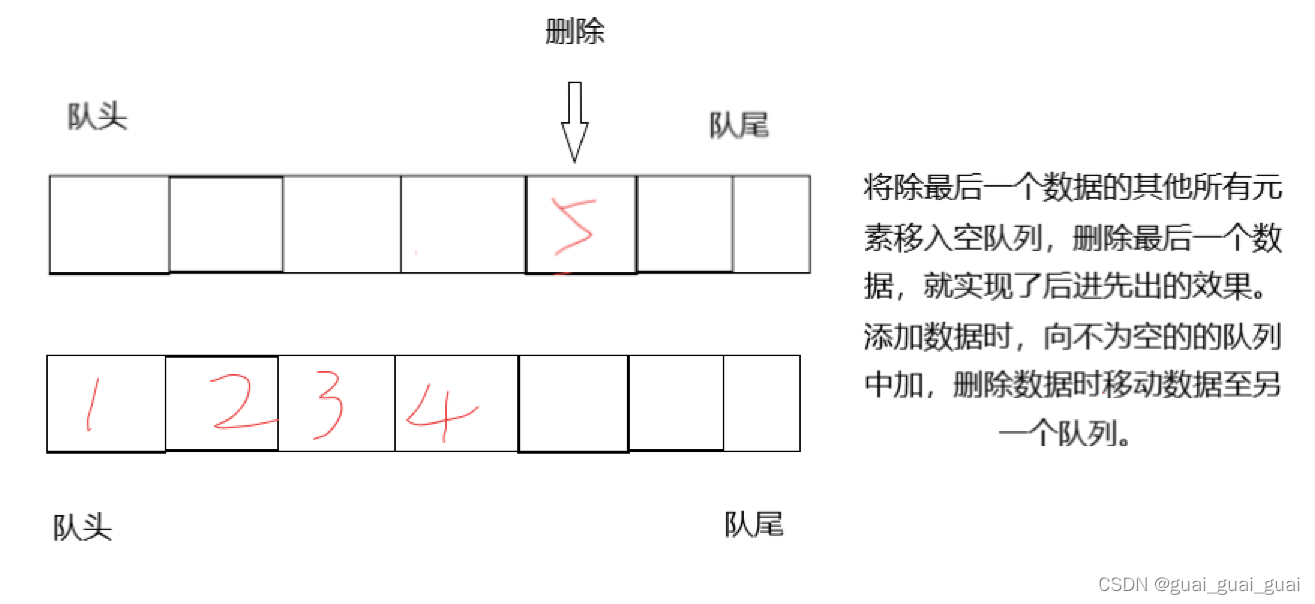问题描述:
请你仅用两个队列实现一个后入先出(LIFO)的栈,并支持普通队列的全部四种操作(push、top、pop和empty)。
实现MyStack类:
- void push(int x) 将元素x压入栈顶。
- int pop()移除并返回栈顶元素。
- int top()返回栈顶元素。
- boolean empty()如果栈是空的,返回true;否则,返回false。
解题思路:

1. 入数据,往不为空的队列入
2. 出数据,把不为空的队列数据导入为空,直至只剩最后一个
解决本题之前,要先将队列的各类接口函数准备好,队列的接口函数我上一篇中提到了喔:
#include<stdio.h>
#include<stdbool.h>
#include<assert.h>
#include<stdlib.h>
typedef int QDataType;
typedef struct QueueNode
{struct QueueNode* next;QDataType data;
}QNode;//删除数据和插入数据需要记录头结点和尾结点
typedef struct Queue
{QNode* head;QNode* tail;
}Queue;
void QueueInit(Queue* pq);
void QueueDestory(Queue* pq);
//队尾入
void QueuePush(Queue* pq, QDataType x);
//队头出
void QueuePop(Queue* pq);
//取队头的数据
QDataType QueueFront(Queue* pq);
//取队尾的数据
QDataType QueueBack(Queue* pq);
//取数据的个数
int QueueSize(Queue* pq);
//判断队列是否为空
bool QueueEmpty(Queue* pq);void QueueInit(Queue* pq)
{assert(pq);pq->head = pq->tail = NULL;
}
void QueueDestory(Queue* pq)
{assert(pq);QNode* cur = pq->head;while (cur){QNode* next = cur->next;free(cur);cur = next;}pq->head = pq->tail = NULL;//返回初始状态
}
//队尾入
void QueuePush(Queue* pq, QDataType x)
{assert(pq);QNode* newnode = (QNode*)malloc(sizeof(QNode));if (newnode == NULL){printf("malloc fail\n");exit(-1);}newnode->data = x;newnode->next = NULL;if (pq->tail == NULL){pq->head = pq->tail = newnode;}else{pq->tail->next = newnode;pq->tail = newnode;}}
//队头出
void QueuePop(Queue* pq)
{assert(pq);assert(pq->head);//断言队列是否为空,为空就不可删除,会有野指针if (pq->head->next == NULL)//当只有一个节点时,tail可能为野指针,tail指向已释放的空间pq->tail = NULL;QNode* next = pq->head->next;free(pq->head);pq->head = next;}
//取队头的数据
QDataType QueueFront(Queue* pq)
{assert(pq);assert(pq->head);return pq->head->data;
}
//取队尾的数据
QDataType QueueBack(Queue* pq)
{assert(pq);assert(pq->head);return pq->tail->data;
}
//取数据的个数
int QueueSize(Queue* pq)
{assert(pq);int size = 0;QNode* cur = pq->head;while (cur){size++;cur = cur->next;}return size;
}
//判断队列是否为空
bool QueueEmpty(Queue* pq)
{assert(pq);return pq->head == NULL;
}通过队列创建栈:
typedef struct
{Queue q1;Queue q2;
}MyStack;
MyStack* myStackCreate()
{MyStack* ps = (MyStack*)malloc(sizeof(MyStack));if (ps == NULL){printf("malloc fail\n");exit(-1);}QueueInit(&ps->q1);//对队列进行初始化QueueInit(&ps->q2);return ps;
}在栈顶添加数据:
添加数据时,要在不为空的队列里添加:
void myStackPush(MyStack* obj, int x)
{if (!QueueEmpty(&obj->q1)){QueuePush(&obj->q1,x);}else{QueuePush(&obj->q2, x);}
}从栈顶处删除数据并返回第一个数据:
int myStackPop(MyStack* obj)
{Queue* emptyQ = &obj->q1;Queue* nonemptyQ = &obj->q2;if (!QueueEmpty(&obj->q1)){emptyQ=&obj->q2;nonemptyQ=&obj->q1;}//倒数据while (QueueSize(nonemptyQ) > 1){//将不空的队列的头拷贝至空队列中QueuePush(emptyQ, QueueFront(nonemptyQ));QueuePop(nonemptyQ);//删除头数据}int top = QueueFront(nonemptyQ);QueuePop(nonemptyQ);//删除最后一个数据,实现了后进先出return top;
}取栈顶的数据:
取不为空的队列的队尾数据:
int myStackTop(MyStack* obj)
{if (!QueueEmpty(&obj->q1)){return QueueBack(&obj->q1);}else{return QueueBack(&obj->q2);}
}判断栈是否为空:
bool myStackEmpty(MyStack* obj)
{return QueueEmpty(&obj->q1) && QueueEmpty(&obj->q2);
}释放栈:
先销毁队列,再释放。
void myStackFree(MyStack* obj)
{QueueDestory(&obj->q1);QueueDestory(&obj->q2);free(obj);
}整体代码:
#include<stdio.h>
#include<stdbool.h>
#include<assert.h>
#include<stdlib.h>
typedef int QDataType;
typedef struct QueueNode
{struct QueueNode* next;QDataType data;
}QNode;//删除数据和插入数据需要记录头结点和尾结点
typedef struct Queue
{QNode* head;QNode* tail;
}Queue;
void QueueInit(Queue* pq);
void QueueDestory(Queue* pq);
//队尾入
void QueuePush(Queue* pq, QDataType x);
//队头出
void QueuePop(Queue* pq);
//取队头的数据
QDataType QueueFront(Queue* pq);
//取队尾的数据
QDataType QueueBack(Queue* pq);
//取数据的个数
int QueueSize(Queue* pq);
//判断队列是否为空
bool QueueEmpty(Queue* pq);void QueueInit(Queue* pq)
{assert(pq);pq->head = pq->tail = NULL;
}
void QueueDestory(Queue* pq)
{assert(pq);QNode* cur = pq->head;while (cur){QNode* next = cur->next;free(cur);cur = next;}pq->head = pq->tail = NULL;//返回初始状态
}
//队尾入
void QueuePush(Queue* pq, QDataType x)
{assert(pq);QNode* newnode = (QNode*)malloc(sizeof(QNode));if (newnode == NULL){printf("malloc fail\n");exit(-1);}newnode->data = x;newnode->next = NULL;if (pq->tail == NULL){pq->head = pq->tail = newnode;}else{pq->tail->next = newnode;pq->tail = newnode;}}
//队头出
void QueuePop(Queue* pq)
{assert(pq);assert(pq->head);//断言队列是否为空,为空就不可删除,会有野指针if (pq->head->next == NULL)//当只有一个节点时,tail可能为野指针,tail指向已释放的空间pq->tail = NULL;QNode* next = pq->head->next;free(pq->head);pq->head = next;}
//取队头的数据
QDataType QueueFront(Queue* pq)
{assert(pq);assert(pq->head);return pq->head->data;
}
//取队尾的数据
QDataType QueueBack(Queue* pq)
{assert(pq);assert(pq->head);return pq->tail->data;
}
//取数据的个数
int QueueSize(Queue* pq)
{assert(pq);int size = 0;QNode* cur = pq->head;while (cur){size++;cur = cur->next;}return size;
}
//判断队列是否为空
bool QueueEmpty(Queue* pq)
{assert(pq);return pq->head == NULL;
}
typedef struct
{Queue q1;Queue q2;
}MyStack;
MyStack* myStackCreate()
{MyStack* ps = (MyStack*)malloc(sizeof(MyStack));if (ps == NULL){printf("malloc fail\n");exit(-1);}QueueInit(&ps->q1);QueueInit(&ps->q2);return ps;
}
void myStackPush(MyStack* obj, int x)
{if (!QueueEmpty(&obj->q1)){QueuePush(&obj->q1,x);}else{QueuePush(&obj->q2, x);}
}
//删除数据且返回栈顶
int myStackPop(MyStack* obj)
{Queue* emptyQ = &obj->q1;Queue* nonemptyQ = &obj->q2;if (!QueueEmpty(&obj->q1)){emptyQ=&obj->q2;nonemptyQ=&obj->q1;}//倒数据while (QueueSize(nonemptyQ) > 1){//将不空的队列的头拷贝至空队列中QueuePush(emptyQ, QueueFront(nonemptyQ));QueuePop(nonemptyQ);//删除头数据}int top = QueueFront(nonemptyQ);QueuePop(nonemptyQ);//删除最后一个数据,实现了后进先出return top;
}int myStackTop(MyStack* obj)
{if (!QueueEmpty(&obj->q1)){return QueueBack(&obj->q1);}else{return QueueBack(&obj->q2);}
}
bool myStackEmpty(MyStack* obj)
{return QueueEmpty(&obj->q1) && QueueEmpty(&obj->q2);
}
void myStackFree(MyStack* obj)
{QueueDestory(&obj->q1);QueueDestory(&obj->q2);free(obj);
}









:进制转换,原码,反码,补码)





手动编译开发库(win10+vs2019))


